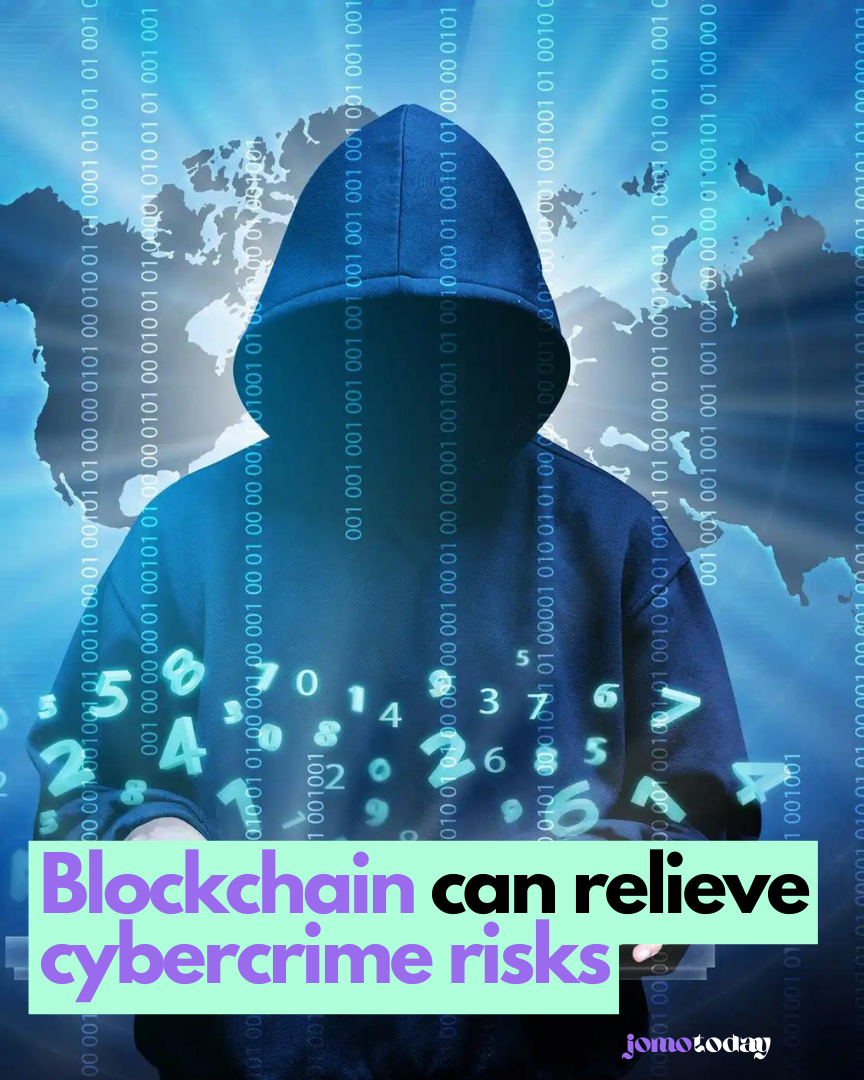Cybercrime continues to escalate unabated, lacking any indication of a slowdown unless a significant intervention disrupts its course.

Each year, cybercrime losses continue to escalate, prompting some experts to suggest that while blockchain technology may not be a perfect solution, its widespread adoption could be a significant step forward. Cybercrime encompasses various illicit activities, including ransomware attacks, identity theft, data breaches, and phishing schemes.
According to Cybersecurity Ventures, global cybercrime losses are projected to soar to $10.5 trillion annually by 2025. Bitcoin (BTC), the inaugural decentralized blockchain and its corresponding cryptocurrency, was introduced in January 2009. Its technology incorporates security measures such as cryptography, decentralization, and consensus mechanisms.
In a conversation with Cointelegraph, Ronghui Gu, co-founder of CertiK, a blockchain security firm, emphasized that blockchain technology is fundamentally a security solution. He highlighted how industries reliant on data integrity, such as healthcare and finance, stand to benefit from its implementation. Gu illustrated this with the example of patient records securely stored on a blockchain, reducing the vulnerability to data breaches and unauthorized access. Furthermore, he noted the potential for patients to have more control over their data, including who accesses it and when.
Several companies are already exploring the use of blockchain for managing medical records, with one even introducing a COVID-19 medical certificate on the blockchain. Gu underscored the vulnerability of centralized data storage systems to cyberattacks and the limitations in current systems for individuals to monitor and manage their data usage effectively.
He believes that blockchain and Web3 technologies tackle numerous challenges by decentralizing data storage, thus mitigating the risks associated with centralized points of failure and unauthorized access. This technology, based on distributed ledger technology, aims to eradicate single points of failure, enhancing resilience against common cyber threats like data tampering and network breaches.
In 2023, CertiK’s annual “Hack3d: The Web3 Security Report” revealed that a staggering $1.8 billion in digital assets vanished in 751 Web3 security breaches. Gu emphasized that while blockchain technology isn’t impervious to cyber threats, its decentralized structure offers robust security. Manipulating a distributed ledger requires control of over half of all machines, making alterations exceedingly difficult once data is recorded.
Gu highlighted that every transaction is safeguarded by robust cryptography, ensuring only authorized users with the correct keys can make changes. According to data from Statista, investment scams incurred the highest losses in the US last year, followed by business email compromise and fraudulent tech support communication.
In 2023, CertiK’s annual “Hack3d: The Web3 Security Report” revealed that a staggering $1.8 billion in digital assets vanished in 751 Web3 security breaches. Gu emphasized that while blockchain technology isn’t impervious to cyber threats, its decentralized structure offers robust security. Manipulating a distributed ledger requires control of over half of all machines, making alterations exceedingly difficult once data is recorded.
Gu highlighted that every transaction is safeguarded by robust cryptography, ensuring only authorized users with the correct keys can make changes. According to data from Statista, investment scams incurred the highest losses in the US last year, followed by business email compromise and fraudulent tech support communication.
Each of these attack scenarios may entail a demand for fund transfers to the perpetrators, leading to financial losses and the potential disclosure of sensitive financial and personnel data.
Gu believes that employing smart contracts could diminish the likelihood of prevalent cyberattacks achieving success. Smart contracts function as transaction protocols designed to execute actions automatically based on predetermined terms. According to Gu, these contracts have the capacity to guarantee that transactions are carried out solely under specific conditions, thereby mitigating fraud risks in the financial sector and streamlining numerous arduous compliance duties.
Blockchain not a silver bullet to stop cybercrime, but it could still help
Gu argues that achieving complete eradication of cybercrime is not feasible due to the dynamic nature of cybersecurity. As technology advances, new vulnerabilities and methods of attack emerge, making it an ongoing challenge. A considerable portion of cybercrime exploits human mistakes, such as weak passwords or falling victim to phishing and social engineering tactics. While education can mitigate these risks to some extent, it’s unrealistic to expect every user to be immune.
Additionally, there’s a socioeconomic aspect to cybercrime; as long as there are incentives, whether financial or otherwise, individuals or groups will continue to engage in criminal activities. According to Statista projections, the amount stolen from victims is anticipated to soar to over $13 trillion by 2028.
Gu suggests that instead of aiming for complete elimination, the focus should be on minimizing and managing cybercrime by building resilient infrastructures and educating users. This strategy maintains the advantages of decentralized technologies while guarding against their inherent risks.
To completely eradicate cybercrime might entail extreme measures that could compromise personal freedoms and privacy, contrary to the values upheld by blockchain technology, as explained by Gu.
Johann Polecsak, co-founder and CTO of QANplatform, noted that while blockchain isn’t a universal solution to cyberattacks, it can enhance security in specific domains. When properly implemented, blockchain can pinpoint key-management issues as potential points of failure, which can then be effectively addressed using hardware-based signing tools.
The advent of quantum computing has instilled concern within the crypto industry, as it poses a potential threat. The fear is that such computing power could compromise blockchain encryption, leading to widespread theft of user funds.
Eskil Tsu, co-founder of GoPlus, a decentralized security data and service network, expressed to Cointelegraph his belief that “only blockchain has the potential to effectively combat cybercrime.”
He highlighted blockchain’s core attributes such as decentralization, transparency, and immutability as pivotal factors that can greatly diminish risks and shrink the avenues for online attacks.
Blockchain tech a possible solution for AI cyberattacks
Fraser Edwards, the co-founder and CEO of Cheqd, a decentralized data infrastructure provider, believes that blockchain technology holds significant potential in thwarting cyberattacks, particularly phishing and impersonation scams.
In a 2024 report by security provider Hornetsecurity, it’s highlighted that phishing remains the predominant email attack method, constituting 43.3% of all email threats.
“Utilizing decentralized identity and credentials, often leveraging blockchain technology, is poised to significantly mitigate the risk of cyberattacks.”
Edwards suggested that blockchain technology might offer a solution to emerging scams and cyber threats, including those leveraging artificial intelligence.
Concerns surrounding AI-generated content have significantly heightened in recent years, as highlighted by the 2024 edition of the World Economic Forum’s “Global Risks Report.”
Deepfakes, in particular, have become a major source of concern. AI-powered video technology can produce computer-generated images and voices that closely resemble real individuals.
A recent deepfake scam resulted in a Hong Kong company losing $25 million after scammers impersonated senior executives during an online video meeting. This incident, noted by Hong Kong police, represents one of the first cases of its kind.
According to data from SumSub, instances of deepfakes increased tenfold across all industries globally from 2022 to 2023.
Edwards noted that it is now feasible to generate fake passport or driver’s license documents, which could be exploited to deceive Know Your Customer (KYC) processes. Additionally, he claimed that once an individual’s account details are obtained, it is typically straightforward to impersonate them through their accounts or applications.
KYC checks are essential procedures for verifying identity when creating an online account on a crypto exchange.
Edwards proposed a potential solution to combat such cybercrimes: the utilization of decentralized identifiers (DIDs). These are unique identifiers similar to URLs, ensuring uniqueness, accessibility, and cryptographic verification.
“DID and credentials automatically enforce 2FA by necessitating authentication not solely through passwords, but also by requiring the correct signature from the wallet or device where the credentials are stored,” he explained.
Furthermore, Edwards highlighted that DIDs and credentials could thwart the generation of fraudulent document images by AI, as they wouldn’t be signed by the authorized issuer, making detection of fraud easier. Similarly, content credentials could prevent the misuse of generated videos.
Read More: Nigeria appoints new experts to reform blockchain policy committee
Disclaimer:
This content is AI-generated using IFTTT AI Content Creator. While we strive for accuracy, it’s a tool for rapid updates. We’re committed to filtering information, not reproducing or endorsing misinformation. – Jomotoday for more information visit privacy policy






Leave a Comment